 Subaru Forester: SUBARU advanced frontal airbag system
Subaru Forester: SUBARU advanced frontal airbag system
Your vehicle is equipped with a SUBARU advanced frontal airbag system that complies with the new advanced frontal airbag requirements in the amended Federal Motor Vehicle Safety Standard (FMVSS) No. 208.
The SUBARU advanced frontal airbag system automatically determines the deployment force of the driver’s SRS frontal airbag at the time of deployment as well as whether or not to activate the front passenger’s SRS frontal airbag and, if activated, the deployment force of the SRS frontal airbag at the time of deployment.
Your vehicle has warning labels on the driver’s and front passenger’s sun visors beginning with the phrase “EVEN WITH ADVANCED AIR BAGS” and a tag attached to the glove box lid beginning with the phrase “Even with Advanced Air Bags”. Make sure that you carefully read the instructions on the warning labels and tag.
Always wear your seatbelt. The SUBARU advanced frontal airbag system is a supplemental restraint system and must be used in combination with a seatbelt. All occupants should wear a seatbelt or be seated in an appropriate child restraint system.
The driver’s SRS frontal airbag is stowed in the center portion of the steering wheel.
The front passenger’s SRS frontal airbag is stowed near the top of the dashboard under an “SRS AIRBAG” mark.
In a moderate to severe frontal collision, the driver’s and front passenger’s SRS frontal airbags deploy and supplement the seatbelts by reducing the impact on the driver’s and front passenger’s head and chest.
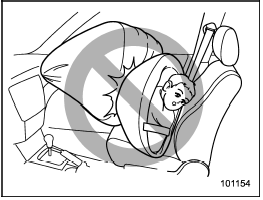

NEVER INSTALL A REARWARD FACING CHILD SEAT IN THE FRONT SEAT. DOING SO RISKS SERIOUS INJURY OR DEATH TO THE CHILD BY PLACING THE CHILD’S HEAD TOO CLOSE TO THE SRS AIRBAG.
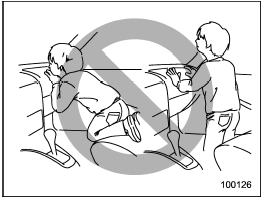

Never allow a child to stand up, or to kneel on the front passenger’s seat.
The SRS airbag deploys with considerable force and can injure or even kill the child.
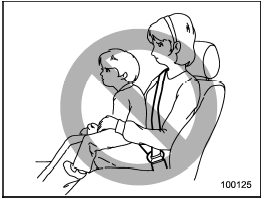

Never hold a child on your lap or in your arms. The SRS airbag deploys with considerable force and can injure or even kill the child.
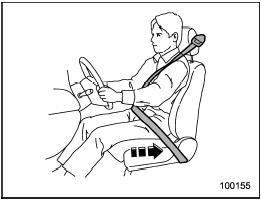

The SRS airbag deploys with considerable speed and force. Occupants who are out of proper position when the SRS airbag deploys could suffer very serious injuries. Because the SRS airbag needs enough space for deployment, the driver should always sit upright and well back in the seat as far from the steering wheel as practical while still maintaining full vehicle control and the front passenger should move the seat as far back as possible and sit upright and well back in the seat.
It is also important to wear your seatbelt to help avoid injuries that can result when the SRS airbag contacts an occupant not in proper position such as one thrown toward the front of the vehicle during preaccident braking.
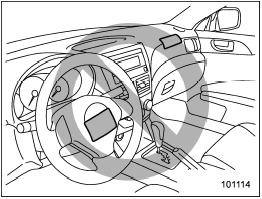

Do not put any objects over the steering wheel pad and dashboard.
If the SRS frontal airbag deploys, those objects could interfere with its proper operation and could be propelled inside the vehicle and cause injury.
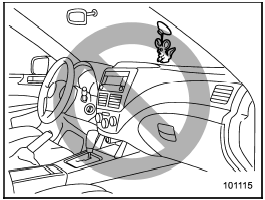

Do not attach accessories to the windshield, or fit an extra-wide mirror over the rear view mirror. If the SRS airbag deploys, those objects could become projectiles that could seriously injure vehicle occupants.
- Driver’s SRS frontal airbag
- Front passenger’s SRS frontal airbag
- Passenger’s frontal airbag ON and OFF indicators
- Conditions in which front passenger’s SRS frontal airbag is not activated
- If the front passenger’s frontal airbag ON indicator illuminates and the OFF indicator turns off even when an infant or a small child is in a child restraint system (including booster seat)
- Conditions in which front passenger’s SRS frontal airbag is activated
- If the passenger’s frontal airbag OFF indicator illuminates and the ON indicator turns off even when the front passenger’s seat is occupied by an adult
- Effect vehicle modifications made for persons with disabilities may have on SUBARU advanced frontal airbag system operation (U.S. only)
- Operation
- Example of accident in which the driver’s/driver’s and front passenger’s SRS frontal airbag(s) will most likely deploy.
- Examples of the types of accidents in which it is possible that the driver’s/driver’s and front passenger’s SRS frontal airbag(s) will deploy.
- Examples of the types of accidents in which deployment of the driver’s/driver’s and front passenger’s SRS frontal airbag(s) is unlikely to occur.
- Examples of the types of accidents in which the driver’s/driver’s and front passenger’s SRS frontal airbag(s) will basically not deploy.
- SRS side airbag and SRS curtain airbag
- Operation
- Example of the type of accident in which the SRS side airbag will most likely deploy.
- Examples of the types of accidents in which the SRS curtain airbag will most likely deploy.
- Examples of the types of accidents in which it is possible that the SRS side airbag and the SRS curtain airbag will deploy.
- Examples of the types of accidents in which the SRS side airbag is unlikely to deploy.
- Examples of the types of accidents in which the SRS curtain airbag is unlikely to deploy.
- Examples of the types of accidents in which the SRS side airbag and SRS curtain airbag will basically not deploy.
- Example of the type of accident in which the SRS curtain airbag will basically not deploy.
 Models with SRS airbags and lap/shoulder restraints for driver, front
passenger, and window-side rear passengers
Models with SRS airbags and lap/shoulder restraints for driver, front
passenger, and window-side rear passengers
Your vehicle is equipped with a supplemental
restraint system in addition to a
lap/shoulder belt at each front seating
position and each rear window-side seating
positions. The supplemental re ...
 Driver’s SRS frontal airbag
Driver’s SRS frontal airbag
The driver’s SRS frontal airbag uses a
dual stage inflator. The inflator operates in
different ways depending on the severity
of impact.
Have the system inspected by your
SUBARU dealer imme ...
See also:
Lower Anchors and Tether for CHildren (LATCH)
Your vehicle’s rear seat is equipped with the child restraint
anchorage system called LATCH. The LATCH
system provides for the installation of the child restraint
without using the vehicle’s ...
Wind Buffeting
Wind buffeting can be described as the perception of
pressure on the ears or a helicopter-type sound in the
ears. Your vehicle may exhibit wind buffeting with the
windows down, or the sunroof (i ...
Off-road vehicle feature
● Specific design characteristics give it a higher center of gravity
than ordinary passenger cars. This vehicle design feature causes
this type of vehicle to be more likely to rollover. And, u ...
